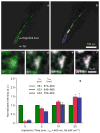Photochemical Barcodes
- PMID: 29561604
- PMCID: PMC6056178
- DOI: 10.1021/jacs.8b00887
Photochemical Barcodes
Abstract
A photochemical strategy to encode fluorescence signals in vivo with spatial control was designed around the unique properties of a photoactivatable borondipyrromethene (BODIPY). The photoinduced disconnection of two oxazines, flanking a single BODIPY, in two consecutive steps produces a mixture of three emissive molecules with resolved fluorescence inside polymer beads. The relative amounts and emission intensities of the three fluorophores can be regulated precisely in each bead by adjusting the dose of activating photons to mark individual particles with distinct codes of fluorescence signals. The visible wavelengths and mild illumination sufficient to induce these transformations permit the photochemical barcoding of beads also in living nematodes. Different regions of the same animal can be labeled with distinct barcodes to allow the monitoring of their dynamics for long times with no toxic effects. Thus, our photochemical strategy for the generation of fluorescence barcodes can produce multiple and distinguishable labels in the same biological sample to enable the spatiotemporal tracking of, otherwise indistinguishable, targets.
Conflict of interest statement
The authors declare no competing financial interest.
Figures






References
-
- Corey EJ, Cheng X-M. The Logic of Chemical Synthesis. Wiley; New York: 1995.
-
- Wolpert L, Tickle C. Principles of Development. Oxford University Press; Oxford: 2010.
-
- Dugatkin LA. Principles of Animal Behavior. Norton & Company; 2014.
-
- Gorris HH, Wolfbeis OS. Angew Chem, Int Ed. 2013;52:3584–3600. - PubMed
Publication types
MeSH terms
Substances
Grants and funding
LinkOut - more resources
Full Text Sources
Other Literature Sources

